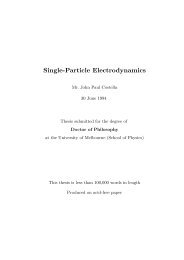Loose ends in the Wellstone crash - Assassination Science
Loose ends in the Wellstone crash - Assassination Science
Loose ends in the Wellstone crash - Assassination Science
- No tags were found...
You also want an ePaper? Increase the reach of your titles
YUMPU automatically turns print PDFs into web optimized ePapers that Google loves.
com<strong>in</strong>g <strong>in</strong> slower than normal, <strong>the</strong> National Transportation Safety Board said.” Because this<strong>in</strong>formation is crucial to understand<strong>in</strong>g <strong>the</strong> case, I quote it here at length.“Earlier this month, safety board <strong>in</strong>vestigators brought to Florida two pilots from AviationCharter, <strong>the</strong> company that flew <strong>Wellstone</strong>’s party, and put <strong>the</strong>m <strong>in</strong>to a simulator similar to <strong>the</strong>K<strong>in</strong>g Air A100. The pilots were given three scenarios for approach<strong>in</strong>g <strong>the</strong> Eveleth-Virg<strong>in</strong>iaMunicipal Airport, with two of <strong>the</strong>m duplicat<strong>in</strong>g <strong>the</strong> <strong>in</strong>structions given to <strong>Wellstone</strong>’s plane.“The f<strong>in</strong>al of <strong>the</strong> three tests asked <strong>the</strong> pilots to wait longer than usual to extend <strong>the</strong> land<strong>in</strong>g gearand beg<strong>in</strong> <strong>the</strong>ir descent to <strong>the</strong> run way. That one significantly <strong>in</strong>creased <strong>the</strong> workload for <strong>the</strong>pilots, accord<strong>in</strong>g to <strong>the</strong> report. They also flew <strong>the</strong> plane at <strong>the</strong> unusually slow speed <strong>the</strong><strong>Wellstone</strong> plane traveled at before <strong>the</strong> <strong>crash</strong>. However, <strong>the</strong> pilots were able to power up <strong>the</strong>eng<strong>in</strong>es and fly <strong>the</strong> simulator out of trouble.“Charles Hvass, Jr., a M<strong>in</strong>neapolis aviation lawyer and pilot, said runn<strong>in</strong>g <strong>the</strong> pilots throughsimulators is a normal procedure <strong>in</strong> accident <strong>in</strong>vestigations. Because <strong>the</strong> plane did not havecockpit voice recorders, <strong>the</strong> <strong>in</strong>vestigators are try<strong>in</strong>g to figure out what happened by fly<strong>in</strong>gdifferent scenarios, he said.”The NTSB also tested a navigational aid, <strong>the</strong> land<strong>in</strong>g beacon, and found that it had notcontributed to <strong>the</strong> <strong>crash</strong>, ei<strong>the</strong>r. A dozen tests conducted between 26 October and 23December 2002 showed that <strong>the</strong> closer <strong>the</strong> plane came to <strong>the</strong> airport, <strong>the</strong> more accurate <strong>the</strong>signal became. Look<strong>in</strong>g at both <strong>the</strong> beacon and <strong>the</strong> simulator, Hvass said, it’s clear <strong>the</strong><strong>in</strong>vestigators are focus<strong>in</strong>g on <strong>the</strong> pilots mak<strong>in</strong>g mistakes because no mechanical problems haveturned up on <strong>the</strong> plane or on <strong>the</strong> ground. “I don’t see anyth<strong>in</strong>g <strong>in</strong> ei<strong>the</strong>r of <strong>the</strong>se that spooksme”, he observed. “You’ve got a work<strong>in</strong>g airplane. It shouldn’t be on <strong>the</strong> ground.”The NTSB has also been <strong>in</strong>vestigat<strong>in</strong>g <strong>the</strong> pilots. Richard Conry, <strong>the</strong> pilot <strong>in</strong> command (PIC),had some 5,200 fly<strong>in</strong>g hours, primarily with small, private planes. Accord<strong>in</strong>g to employmentrecords <strong>in</strong> <strong>the</strong> possession of Charter Aviation, he had over 4,600 hours as pilot-<strong>in</strong>-command(PIC), <strong>in</strong>clud<strong>in</strong>g 200 hours as PIC of K<strong>in</strong>g Air A100s. Rees cites some anecdotal reports frompilots who criticized Conry, which I discussed <strong>in</strong> <strong>the</strong> Reader (13 March 2003), but he ignoreso<strong>the</strong>r evidence from <strong>the</strong> NTSB.“Mr. Conry was described by several <strong>in</strong>dividuals as very meticulous and ‘by <strong>the</strong> book’. He wasalso described as calm and very ‘laid back’. One <strong>in</strong>dividual who made about 50 flights <strong>in</strong> a C-172 with Mr. Conry, described him as <strong>the</strong> most careful pilot he had ever flown with. Mr.Conry checked everyth<strong>in</strong>g on every flight”, as <strong>the</strong> NTSB reported (seehttp://www.wcco.com/content/local_file_052162555).I would suggest that a pilot who has flown with Conry about 50 times is somewhat betterpositioned to comment on his qualifications than o<strong>the</strong>rs, such as Bangs and Rees, who havenever flown with him. But, fortunately, <strong>the</strong>re is objective evidence that Conry was competent tofly this plane, namely, that he had passed his FAA professional proficiency “check ride” on 23








